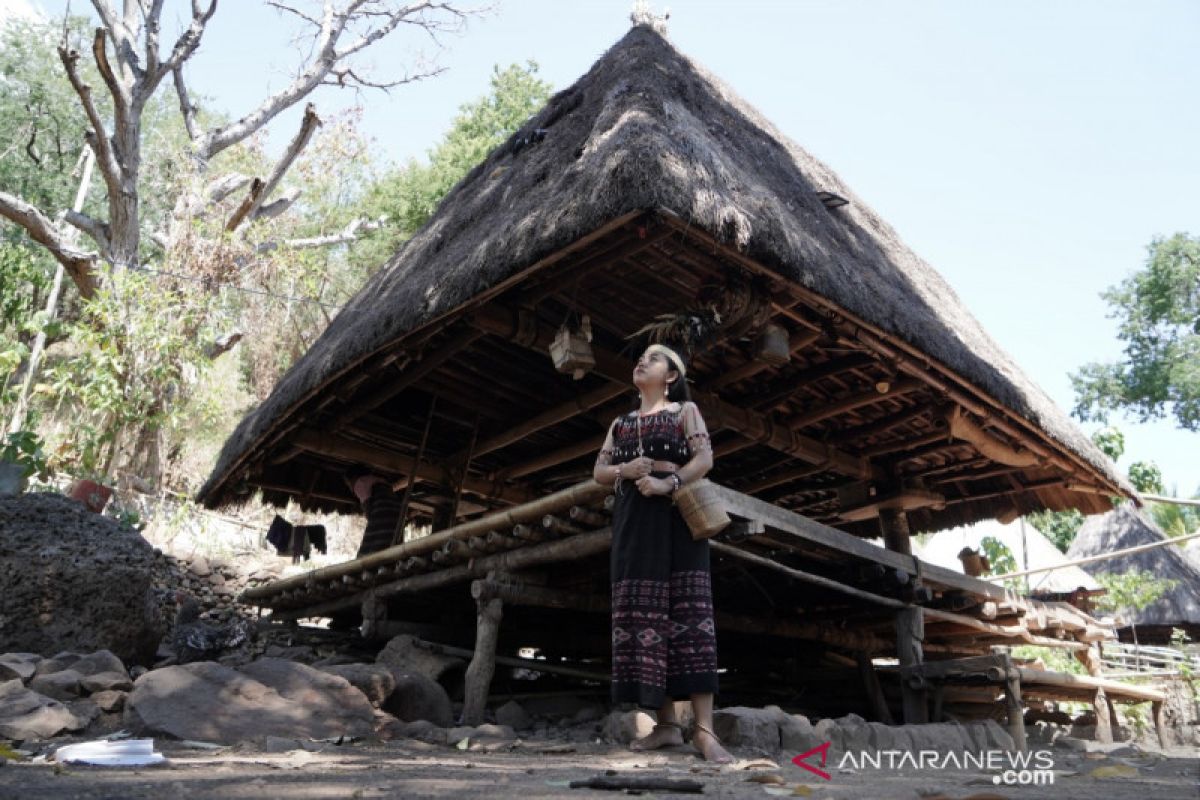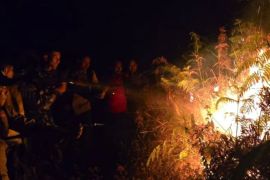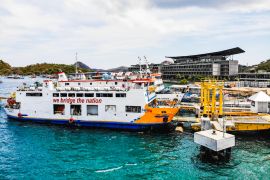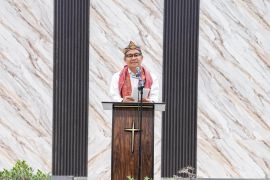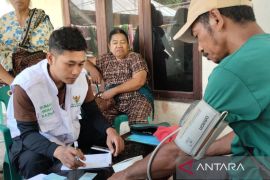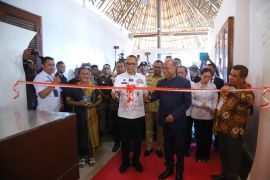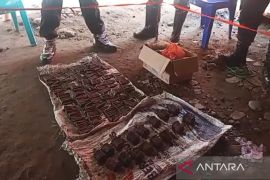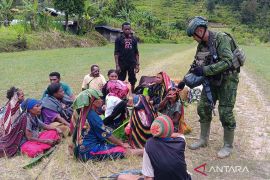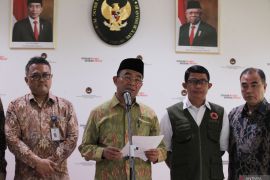Among Alor Island's attractions are its numerous diving spots, such as Half Moon Bay and Crocodile Rock, which have attracted global attention.
The island has yet another draw: its cultural heritage village, Takpala.
The village has been in the spotlight since 1973 when a Dutch tourist used pictures showing the traditional lives of its residents on a calendar. The pictures attracted many more European tourists to the village.
Since then, Takpala Village has remained a draw for foreign tourists. The village won second place for the most traditional village in Indonesia in 1980. In 1983, the Alor district government declared Takpala village as Alor's tourism icon.
"Nowadays, Takpala Village is home to 13 families from the Abui Tribe, which is the largest tribe in Alor," head of Alor Tourism Service, Ati Obidje, said.
At first, the tribe lived in a secluded area in the mountainous region of Alor. Later, officials serving the king of Alor shifted the tribe's members to a hilly area to make tax collection easier.
The word "Takpala" is derived from "tak", which means "limit" and the word "pala", which means "wood". So, the word "Takpala" means "wood barrier".
Traditional House
Takpala Village is located in Lembur Barat village, Alor Tengah Utara sub-district, Alor district, East Nusa Tenggara province.
It is a 15-minute car drive from Mali Airport, and 25 minutes from Kalabahi, the city center of Alor district.
A car trip to Takpala Village offers breathtaking views of the coastline and the deep blue ocean.
In the village, 13 Fala Foka traditional houses greet tourists with their distinctive architecture. The traditional houses are shaped like pyramids, with thatched roofs, woven bamboo walls and floors, and are propped up by four sturdy red wooden stilts.
Each building has four storeys. The first, Liktaha, serves as a living room; the second one, Fala Homi, serves as a place to sleep and cook; the third, Akui Foka, serves as a storage area for food such as corn and cassava; and, the fourth, Akui Kidding, serves as a place to secure dowry or family treasures, such as Moko.
Moko comprises valuable goods, such as pottery, that are commonly used as wedding dowry. Moko is valued highly by residents, and rumor has it that one Moko is enough to propose to three brides.
Beyond the 13 Fala Foka traditional houses are two smaller houses called Lopo that have a holier significance for the residents.
At first glance, the two houses look similar, but there is one crown on each house that represents the sacredness of the building.
The two Lopo houses are called Kolwat and Kanuruat. Kolwat, which means "woman", predominantly has white paint on the walls and is accessible to all village residents.
Meanwhile, Kanuruat, which means "man", is adorned in dark patterns. Only well-respected members of the village, such as the tribe elder, are allowed to enter the building. Once in a year, Kanuruat's door is opened by the tribe elder for traditional rituals.
In front of the Kolwat and Kanuruat building is a circular stone arrangement for storing sacred objects, such as Moko, Gong, or hunting equipment for traditional rituals.
The villagers always welcome tourists with a ceremony and a traditional dance called the Lego-Lego Dance. During the dance performance, all village residents wear traditional clothes. The men carry arrows, bows, and machetes, while the women wear bracelets on both legs and sport fu'ulak bags.
Tourists are allowed to take pictures wearing traditional Takpala clothes. Men can wear bows, arrows, spears, kamol bags, and swords, while women can wear woven cloth, scarves, and fu'ulak bags.
Tourists need to pay owners of the clothes and accoutrements if they want to take a picture with the outfits.
When welcoming tourists, residents usually perform the Lego Luh dance, which is followed by a war dance called Lego Cakalele Doka, performed by two adult men holding bows, arrows, and swords as if they are about to fight.
The closing dance is performed by all family members. Tourists are allowed to join in the dance and circumambulate the Mesbah Stone. The dances are performed on prior notice from tourists.
The daily routine in this village for men comprises farming and hunting, while the women weave and make handicrafts, such as necklaces, bracelets, and rings from forest walnuts, leadtrees seeds, bahar root, and bags of woven bamboo called fu'ulak and Kamol.
The fu'ulak bag is a rectangular bag for women. The Kamol bag made of woven bamboo is similar but meant for men. Both types of bags are commonly used to store money or betel nuts. The handicrafts are usually sold to tourists.
Located at the top of a hill, Takpala Village offers tourists breathtaking views of Mutiara Bay. Tourists will also find the cool breeze from the surrounding trees refreshing.
Thematic Tourist Village
Takpala Village is one of the traditional villages that have been included in the list of thematic tourist village areas developed by the Labuan Bajo Flores Authority Agency (BPOLBF). Currently, there is another tourist village in Alor developed by BPOLBF besides Takpala, called Matalafang Village.
BPOLBF president director Shana Fatina said that the Ministry of Tourism and Creative Economy always supports the development of tourism potential, especially in tourist villages.
"The supports from BPOLBF come in a form of increasing management capacity, both attractions and content, as well as the promotion," Fatina added.
Takpala Village has been included in the thematic village tourism travel map in order to support Labuan Bajo as a super premium tourism area, she said.
Nevertheless, there are several things that need to be improved at the thematic tourist villages, she noted. The tourism villages could improve how they present information to the tourists by adding narratives, basic demographic information, and also sharing folklore, traditional beliefs, and legends from the village, she suggested.
In addition, alternative activities need to be added so that tourists can stay longer in such areas, she said. Handicrafts such as souvenirs also need improvement in packaging to make the merchandise more marketable and boost the community's economy. she added.
In order to increase tourist visits, the Alor Regional Government is currently planning to build a vacation home or "home stay" to encourage longer stays, Fatina said.
Longer stay will help tourists to learn about the life of the people in the traditional village and also generate more income for locals, she explained.
However, such a plan will be difficult to execute since the budget for tourism in 2021 has been diverted into COVID-19 handling, she said.
All stakeholders certainly hope that the pandemic will end soon so that the community's economy will rise again, and cultural tourism destinations will see tourists again, she added.
Related news: Govt building 200 tourism villages to boost Labuan Bajo's appeal
Related news: 2022 G20 Summit to positively impact Labuan Bajo's creative economy
Related news: President keen on developing Labuan Bajo as premium tourism zone
Editor: Suharto
Copyright © ANTARA 2021
